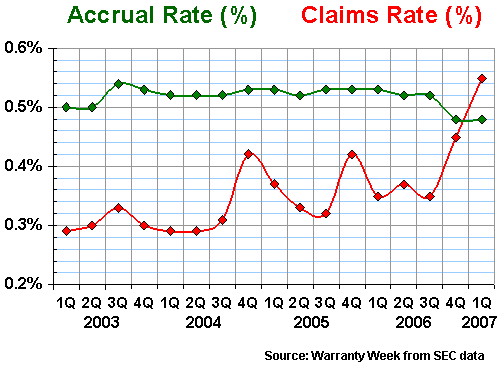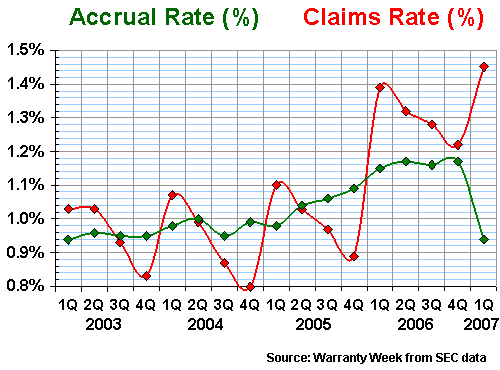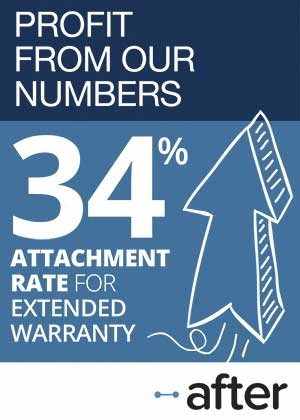New Home Warranties:
While sales are declining, warranty accruals are declining even faster. Is it because of warranty cost cutting? Could it be better quality construction? Or are they simply putting less aside and hoping that nobody notices? Also, a letter to the editor about compliance with state laws on service contracts.
Last week, in an article titled "Bonfire of the Homebuilders," Business Week magazine announced the end of the housing boom and the beginning of the cleanup.
Builders have reacted predictably to the once-skyrocketing price of homes by building too many. Lenders, it seems, have helped buyers to exaggerate their incomes so they could qualify for mortgages they cannot afford. Now some of those new homes are empty, either because nobody bought them or the buyers foreclosed.
So what does this have to do with warranty? Rising markets allow manufacturers to finance old claims with new sales revenue. But declining markets test the ability of manufacturers to pay claims as this source of funds dry up. So we set out to see how the roughly two dozen publicly-held homebuilders have reacted to the downturn.
Warranty Theory
In theory, a warranty reserve fund exists to shield a company from spikes and troughs in either claims or sales. In theory, at the time a product is sold a company puts aside in accruals enough funds to finance all expected warranty claims for that product. In the case of a house, if a company expects an average of $3,000 in warranty claims for every home it builds, it should be accruing $3,000 every time it sells a house.
If a company did this consistently, at any given moment its warranty reserve would hold precisely enough funds to pay every future warranty claim on every product still under warranty -- even if sales suddenly ceased. In practice, however, the lawyers usually discover after a catastrophic work stoppage (such as a bankruptcy followed by a liquidation) that the warranty reserve was long ago raided by managers desperate for cash flow. Claims were paid but accruals slowed to a trickle, so that by the time the liquidators take charge the reserve is nearly empty.
So much for theory. Now here's the math. The warranty claims rate and the warranty accrual rate are computed by dividing each respective amount by sales. If that house sells for $300,000, then the accrual rate is 1%, equal to $3,000 divided by $300,000. And unless either prices or product quality are changing radically, the accrual rate should remain more or less the same over time.
The claims rate, on the other hand, will rise and fall dramatically. Remember, claims are paid on products sold in the past, using funds set aside in the past. So current claims have no relationship to current sales. Yet we still divide claims by current sales to compute a claims rate. But this gives us misleading information, because if sales are soaring, the claims rate will be artificially depressed. If sales are plummeting, the claims rate will be exaggerated.
Sales Declines
Well, sales are plummeting, rather suddenly and rather recently. Out of 28 companies tracked by Warranty Week, 27 saw their homebuilding revenue decline during the first calendar quarter of 2007, as compared to the first quarter of 2006. Comstock Homebuilding Companies Inc. was the sole exception, turning in an 18% sales increase. Overall, quarterly revenue fell almost 26%, from $27 billion in the first quarter of 2006 to $20 billion in 2007.
Figure 1
New Home Builders
Quarterly Homebuilding Revenue, 2003 to 2007
(in $ Billions)

Figure 1 shows how a somewhat disappointing fourth quarter for publicly-held homebuilders was followed by a shockingly disappointing first quarter this year. The Business Week article said 27% of new homes were built by publicly-held corporations in 2006, so the total market could be almost four times as large as is counted here.
But notice the seasonal pattern in sales during the past four years. Sales were always better in the third and fourth quarters than in the first and second quarters. So 2007 could still turn out to be a good year is there's a late surge in sales. But what's worrisome is that this year started lower than either 2005 or 2006.
So what's happened to warranty accruals? In theory, accruals should also be down by 26%, because each homebuilder would still be setting aside the same amount per home sold. But there would be less homes sold. And the good news is that industry-wide accruals are down by 28%, which is close enough to exact when you're working with real world data.
Accruals Cut By Two-Thirds?
What's strange is how several large companies cut their accruals by a lot more than sales. For instance, Centex Corp. saw homebuilding revenue decline by 14% in the quarter ended March 31. Yet it cut accruals by 66%. In what was the fourth quarter of its fiscal year ended March 31, 2006, homebuilding revenue was $3.6 billion and accruals were $15.8 million. In the fourth fiscal quarter of 2007, homebuilding revenue was $3.1 billion and accruals were $5.4 million.
Only two of the 27 companies that saw revenue fall also increased their warranty accruals during the same period: Meritage Homes Corp. and Hovnanian Enterprises Inc. Two companies -- Beazer Homes USA Inc. and Dominion Homes Inc. -- made no accruals in either 2006 or 2007. Therefore, year-over-year percentage comparisons were not possible.
That leaves 23 others that reduced the amount they set aside as warranty accruals during the first quarter of 2007, as compared to 2006. Of those, 13 reduced accruals by more than the sales decrease, and eight of those, led by Centex, did so by very large margins.
This was somewhat counterbalanced by the 10 companies that reduced accruals by somewhat less than their sales declines. For instance, Toll Brothers Inc. saw sales fall by 18%, but it cut accruals by only 12%. The Ryland Group Inc. saw sales fall by 35%, but cut accruals by only 8%.
Overall industry accruals were down by 28% in dollar terms. But because sales fell by close to that amount, the accrual rate remained relatively unchanged: 0.94% in the first quarter of 2006 and 0.91% in the first quarter of 2007. These and other figures are incorporated into the chart in Figure 2.
Figure 2
New Home Builders
Quarterly Warranty Accruals, 2003 to 2007
(in $ Millions and % of Sales)

Notice that the total accrual for the first quarter was the lowest since the beginning of 2003. But because sales are also at a low point, the accrual rate has remained close to the 1% level where it's been for most of the past four years. And that's as it should be: there are no accruals unless and until a home is sold.
That makes it all the more puzzling why some of the largest homebuilders would radically alter their accrual rates as sales faltered. We searched their annual and quarterly statements for news of quality breakthroughs or radical new efficiencies in claims processing, but all we found were the same old boilerplate statements about estimation methodologies.
Below are the actual figures for the ten largest publicly-held homebuilders. Seven cut accruals by more than sales, and two cut accruals by less. The tenth, Beazer Homes, made no accruals during the first quarter of 2006 (did it not sell any homes?) so we couldn't compute the percentage change.
Figure 3
New Home Builders
Annual Change in Revenue & Accruals
First Quarter 2006 vs. First Quarter 2007
(in millions of US dollars)
| Home | Change | Warranty | Change | |
| Company | Revenue | from | Accruals | from |
| Name | 1Q07 | 1Q06 | 1Q07 | 1Q06 |
| Centex Corp. | $3,120 | -14% | $5.4 | -66% |
| Lennar Corp. | $2,663 | -14% | $27 | -31% |
| D.R. Horton Inc. | $2,522 | -27% | $12 | -34% |
| Pulte Homes Inc. | $1,830 | -37% | $17 | -49% |
| KB Home | $1,763 | -19% | $13 | -25% |
| Hovnanian Enterprises | $1,136 | -8.8% | $8.4 | +16% |
| NVR Inc. | $1,075 | -9.2% | $8.2 | -20% |
| Toll Brothers Inc. | $1,054 | -18% | $7.5 | -12% |
| Beazer Homes | $777 | -37% | $4.5 | na |
| MDC Holdings | $712 | -37% | $6.4 | -44% |
| Other | $3,353 | -40% | $72 | -22% |
| Total | $20,004 | -26% | $182 | -28% |
Source: Warranty Week from SEC data
Admittedly, three of the seven that cut accruals by more than sales fell, did so by only a slight margin. For KB Home, the difference was only 5%. For D.R. Horton and MDC Holdings, the difference was only 7%. But that still leaves unexplained the actions of Centex, Lennar, Pulte, and NVR.
They say a picture's worth a thousand words, so let's put some of this data into charts. First, let's look at a company that's held accruals more or less stable. A year ago, D.R. Horton's accrual rate was 0.53%. Now it's 0.48%. Mathematically, that's a 7% difference, but in pictures it's only a slight dip in an otherwise straight line.
Figure 4
D.R. Horton Inc.
Warranty Claims & Accruals, 2003 to 2007
(As a % of Homebuilding Revenue)

In the four-plus years we've been tracking the company, D.R. Horton's accrual rate has never been lower than it is now. Yet it's never been higher than 0.54%. Again, with real world data, this is more or less a straight line.
Notice also how the company's claims rate has frequently spiked during the fourth quarter. Part of that has to do with the seasonal pattern of claims, and part of that has to do with the seasonal pattern of sales. And then notice how the claims rate soared early this year as sales tanked. But the claims the company paid in early 2007 were probably on homes built in 2006 or 2005.
Near Constant Accrual Rate
But whether a home is sold in spring or winter, D.R. Horton sets aside roughly a half of one percent of its sales revenue to finance future warranty claims. And that's the way it should be. Barring any breakthroughs in quality or efficiency or some radical price changes, the accrual rate should stay close to constant as a company continues setting aside the same amount per unit sold.
Now let's look at one of the companies that cut its accrual rate by a large margin. A year ago, Pulte Homes was setting aside 1.15% of its home sales revenue as warranty accruals. In fact, it kept to this rate throughout 2006, ultimately setting aside $165 million on sales of $14 billion.
And then in the first quarter of 2007, it set aside only half as much as it did in the same quarter a year ago. Granted, sales were down, but only by 37%. The accrual rate fell to 0.94%, as is detailed in Figure 5.
Figure 5
Pulte Homes Inc.
Warranty Claims & Accruals, 2003 to 2007
(As a % of Homebuilding Revenue)

What makes the move all the more puzzling is that claims -- which were at a high point throughout 2006 -- went even higher in early 2007. The warranty reserve, which grew in size every year from 2003 to 2005, plateaued in 2006 and is now contracting. As of June 30, the reserve stood at $102 million, a reduction of more than $15 million since the beginning of the year. And the company, which made nearly $263 million on sales of $2.9 billion in the first quarter of 2006, has now begun reporting quarterly net losses.
A Public Bonfire?
In the old days, before publicly-traded and US-based companies were required to reveal the magnitude of all their guarantees, including warranties, these kinds of fluctuations took place behind closed doors. Shareholders never knew whether claims were increasing or decreasing, how much was being set aside per unit of sale, or whether the warranty reserve was growing or contracting.
If a "bonfire of the homebuilders" really is now under way, this could be the first instance where the warranty spending patterns of an industry in contraction can be measured in detail by outsiders. So far, the early results are less than reassuring.
Letter to the Editor
To the editor:
I read with interest your recent article regarding ServiceBench's extended warranty solution for manufacturers [Warranty Week, July 25, 2007]. As an attorney who has handled warranty regulatory compliance matters for a variety of providers, including manufacturers, I was particularly interested in the discussion of the challenges manufacturers face with respect to compliance with the various state service contract regulatory schemes. I wanted to take this opportunity to more fully discuss these issues, including the opportunities for manufacturers to take advantage of lessened regulatory burdens that exist by virtue of the manufacturers' relationship to the products covered under their service contracts.
Several states limit, or eliminate entirely, regulatory oversight of manufacturers who issue service contracts. This is particularly true in Florida and Oklahoma, which are discussed in detail in your article. The full regulatory schemes of those states may not be applicable to manufacturer service contract providers, under certain circumstances. However, Florida and Oklahoma are not alone in their differing treatment of manufacturers.
Manufacturers may be entirely exempt from regulation under Oklahoma's Service Warranty Insurance Act based upon the Act's definition of "service warranty." See 36 Okla. St. § 6602(14). Contracts sold by manufacturers or their affiliates and subsidiaries which are backed by a contractual liability insurance policy are not included in the Act's definition of "service warranty;" likewise, the term does not include any such contracts issued by a company which has net assets in excess of $100 million. A manufacturer demonstrating that it meets either of these exemptions is not required to be licensed in Oklahoma to issue service warranties, and in fact, is exempt entirely from Oklahoma's regulatory scheme.
Florida offers a separate and distinct service warranty association license for manufacturers of consumer products which allows a company that qualifies as a "manufacturer" to obtain a license through a streamlined application process. See §§ 634.401(17) & 634.404(6), Fla. Stat. For instance, Florida does not require fingerprinting of officers and directors of manufacturer service warranty associations and, upon licensure, only requires a simplified annual financial report in lieu of the more burdensome quarterly reports required of non-manufacturers. See § 634.415(4), Fla. Stat. In addition, a manufacturer with a net worth of $100 million and net assets of $750,000 may qualify for a further exemption under Florida law which eliminates the need to comply with (1) the unearned premium reserve/contractual liability insurance requirement; and (2) the premiums-to-net-assets ratio, both of which are otherwise required of service warranty associations. See § 634.406(8). Fla. Stat.
Outside of these two states, there are further opportunities for manufacturers to limit or completely eliminate the regulatory burdens placed on service contract providers, by virtue of their status as manufacturers. Existing regulatory schemes in states such as Alabama, Arizona, Kentucky, New Mexico, New York, Vermont, and Wisconsin contain manufacturer exemptions from licensure and/or regulation, depending on the specific circumstances of the manufacturer. New regulatory schemes enacted this year in Arkansas and Missouri contain similar exemptions for manufacturers. Identifying these opportunities and constructing a compliant service contract program which limits regulatory burdens, and their associated costs, is vitally important for manufacturers who want to maintain control over their extended warranty programs.
The Frost Brown Todd Insurance Industry Practice Group has advised numerous clients regarding the implementation and maintenance of comprehensive national service contract programs, including state licensure, solvency, and disclosure requirements. We look forward to further discussion of these and other warranty-related topics in Warranty Week and welcome the opportunity to contribute to these discussions in order to enhance the understanding of this complex area of the law.
Respectfully,Christopher J. Karo
Counsel
Frost Brown Todd LLC
ckaro@fbtlaw.com
The editor responds:
Thank you for that information. I'm sure many of the manufacturers contemplating their own launches of extended warranty offers will be happy to hear they can take advantage of these and other exemptions in state laws.
But this only reinforces my point, which is that state insurance law compliance is an enormous task which will require legal advice and assistance. I have heard numerous times about manufacturers who tried to do it themselves and who found their service contract operations in one state or another temporarily shut down for noncompliance. Hopefully, everyone who reads your letter will know better than to try to go it alone without the benefit of expert advice.








